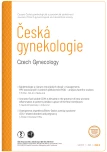Osteogenesis imperfecta/ Ehlers-Danlosův syndrom (COL1-asociované onemocnění) v těhotenství
Autoři:
A. Šinská
; E. Hostinská
; Radovan Pilka
Působiště autorů:
Department of Obstetrics and Gynecology, Faculty of Medicine, Palacky University and University Hospital Olomouc
Vyšlo v časopise:
Ceska Gynekol 2022; 87(6): 396-400
Kategorie:
Kazuistika
doi:
https://doi.org/10.48095/cccg2022396
Souhrn
Ehlers-Danlosův syndrom je označení pro skupinu onemocnění pojivových tkání, které může během gravidity vést k řadě komplikací. Manifestuje se hyperextensibilní kůži, špatným hojením, hyperflexibilitou nebo vyšším rizikem poškození různých orgánů (ruptura dělohy, disekce aorty). Kombinace Ehlers-Danlosova syndromu a osteogenesis imperfecta je velmi zřídkavá (dle Orphanetu < 1/1 000 000). Prezentujeme kazuistiku gravidity, u pacientky s osteogenesis imperfecta/Ehlers-Danlosovým syndromem, komplikovanou dilatací aorty. Naší kazuistikou chceme poukázat na možné komplikace související s graviditou u tohoto velmi raritního, ale extrémně závažného syndromu.
Klíčová slova:
těhotenství – osteogenesis imperfecta – disekce aorty – Ehlers-Danlosův syndrom – COL1-asociované onemocnění
Zdroje
1. Marini JC, Cabral WA. Osteogenesis imperfecta. Chapter 23. In: Thakker RV, Whyte MP, Eisman J et al (eds). Genetics of bone biology and skeletal disease. 2nd ed. USA, CA, Sand Diego: Elsevier (Academic Press) 2018: 397–414.
2. Lindahl K, Åström E, Rubin CJ et al. Genetic epidemiology, prevalence, and genotype-phenotype correlations in the Swedish population with osteogenesis imperfecta. Eur J Hum Genet 2015; 23 (8): 1042–1050. doi: 10.1038/ejhg. 2015.81.
3. Beighton P, De Paepe A, Steinmann B et al. Ehlers-Danlos syndromes: revised nosology, Villefranche, 1997. Ehlers-Danlos national foundation (USA) and Ehlers-Danlos support group (UK). Am J Med Genet 1998; 77 (1): 31–37. doi: 10.1002/ (sici) 1096-8628 (1998028) 77: 1<31:: aid-ajmg8>3.0.co; 2-o.
4. Germain DP. Clinical and genetic features of vascular Ehlers-Danlos syndrome. Ann Vasc Surg 2002; 16 (3): 391–397. doi: 10.1007/ s10016- -001-0229-y.
5. Spiegel E, Nicholls-Dempsey L, Czuzoj-Shulman N et al. Pregnancy outcomes in women with Ehlers-Danlos syndrome. J Matern Neonatal Med 2020; 35 (7): 1683–1689. doi: 10.1080/14767058.2020.1767574.
6. Kang J, Hanif M, Mirza E et al. Ehlers-Danlos syndrome in pregnancy: a review. Eur J Obstet Gynecol Reprod Biol 2020; 255: 118–123. doi: 10.1016/j.ejogrb.2020.10.033.
7. Malfait F, Francomano C, Byers P et al. The 2017 international classification of the Ehlers–Danlos syndromes. Am J Med Genet C Semin Med Genet 2017; 175 (1): 8–26. doi: 10.1002/ajmg.c.31552.
8. Sundelin HE, Stephansson O, Johansson K et al. Pregnancy outcome in joint hypermobility syndrome and Ehlers-Danlos syndrome. Acta Obstet Gynecol Scand 2017; 96 (1): 114–119. doi: 10.1111/aogs.13043.
9. Lind J, Wallenburg HC. Pregnancy and the Ehlers-Danlos syndrome: a retrospective study in a Dutch population. Acta Obstet Gynecol Scand 2002; 81 (4): 293–300. doi: 10.1034/j.1600-0412.2002.810403.x.
10. Parry S, Strauss JF 3rd. Premature rupture of membranes. N Engl J Med 1998; 338 (10): 663–670. doi: 10.1056/NEJM199803053381 006.
11. Byers PH, Belmont J, Black J et al. Diagnosis, natural history, and management in vascular Ehlers-Danlos syndrome. Am J Med Genet Part C Semin Med Genet 2017; 175 (1): 40–47. doi: 10.1002/ajmg.c.31553.
12. Murray ML, Pepin M, Peterson S et al. Pregnancy-related deaths and complications in women with vascular Ehlers-Danlos syndrome. Genet Med 2014; 16 (12): 874–880. doi: 10.1038/gim.2014.53.
13. Regitz-Zagrosek V, Roos-Hesselink JW, Bauersachs J et al. 2018 ESC guidelines for the management of cardiovascular diseases during pregnancy. Eur Heart J 2018; 39 (34): 3165–3241. doi: 10.1093/eurheartj/ehy340.
14. Kiilholma P, Grönroos M, Näntö V et al. Pregnancy and delivery in Ehlers-Danlos syndrome. Role of copper and zinc. Acta Obstet Gynecol Scand 1984; 63 (5): 437–439. doi: 10.3109/00016348409156699.
15. Volkov N, Nisenblat V, Ohel G et al. Ehlers--Danlos syndrome: insights on obstetric aspects. Obstet Gynecol Surv 2007; 62 (1): 51–57. doi: 10.1097/01.ogx.0000251027.32142.63.
16. Brighouse D, Guard B. Anaesthesia for caesarean section in a patient with Ehlers-Danlos syndrome type IV. Br J Anaesth 1992; 69 (5): 517–519. doi: 10.1093/bja/69.5.517.
17. Campbell N, Rosaeg OP. Anesthetic management of a parturient with Ehlers-Danlos syndrome type IV. Can J Anaesth 2002; 49 (5): 493–496. doi: 10.1007/BF03017928.
18. Edelu B, Ndu I, Asinobi I et al. Osteogenesis imperfecta: a case report and review of literature. Ann Med Health Sci Res 2014; 4 (Suppl 1): S1–S5. doi: 10.4103/2141-9248.131683.
19. Chamunyonga F, Masendeke KL, Mateveke B. Osteogenesis imperfecta and pregnancy: a case report. J Med Case Rep 2019; 13 (1): 363. doi: 10.1186/s13256-019-2296-0.
20. Yimgang DP, Brizola E, Shapiro JR. Health outcomes of neonates with osteogenesis imperfecta: a cross-sectional study. J Matern Fetal Neonatal Med 2016; 29 (23): 3889–3893. doi: 10.3109/14767058.2016.1151870.
21. Morlino S, Micale L, Ritelli M et al. COL1-related overlap disorder: a novel connective tissue incoroporating the osteogenesis imperfecta/Ehlers-Danlos syndrome overlap. Clin Genet 2020; 97 (3): 396–406. doi: 10.1111/cge. 13683.
22. Raff ML, Craigen WJ, Smith LT et al. Partial COL1A2 gene duplication produces features of osteogenesis imperfecta and Ehlers-Danlos syndrome type VII. Hum Genet 2000; 106 (1): 19–28. doi: 10.1007/s004390051004.
Štítky
Dětská gynekologie Gynekologie a porodnictví Reprodukční medicínaČlánek vyšel v časopise
Česká gynekologie

2022 Číslo 6
Nejčtenější v tomto čísle
- Nová kombinovaná perorální antikoncepce obsahující estetrol: přehledový článek evropského panelu odborníků
- Endometrióza v postmenopauze
- Vybrané patologické stavy ovlivňující receptivitu endometria
- Karcinom vulvy a jeho recidivy – zásady operační léčby
